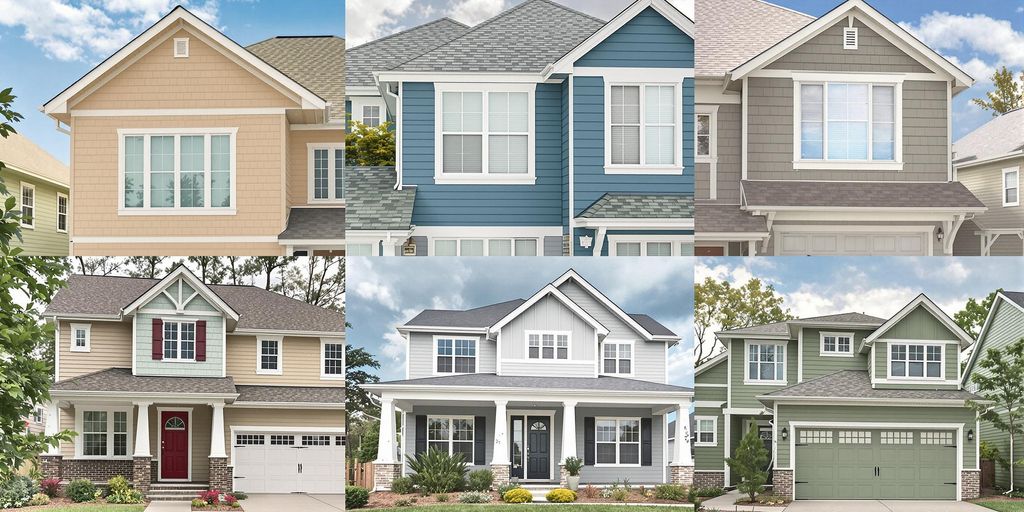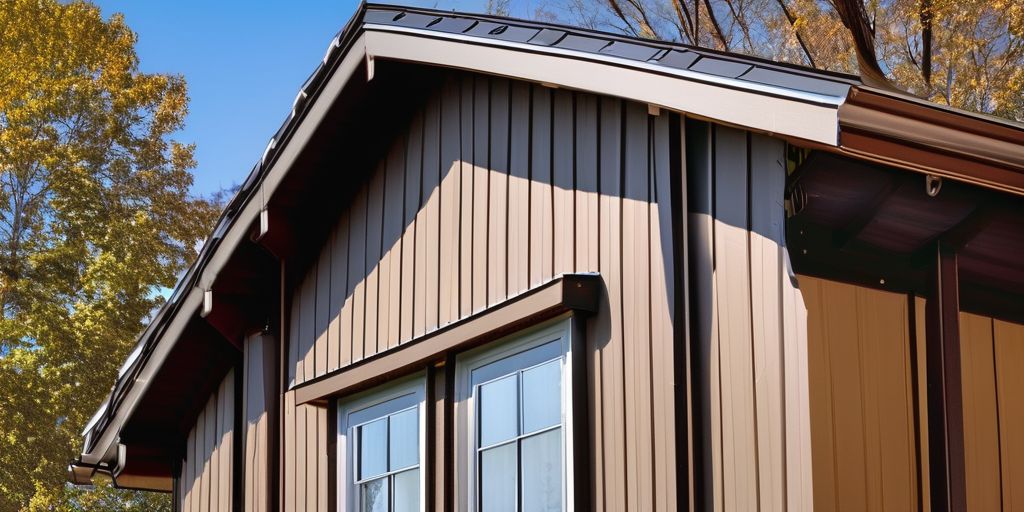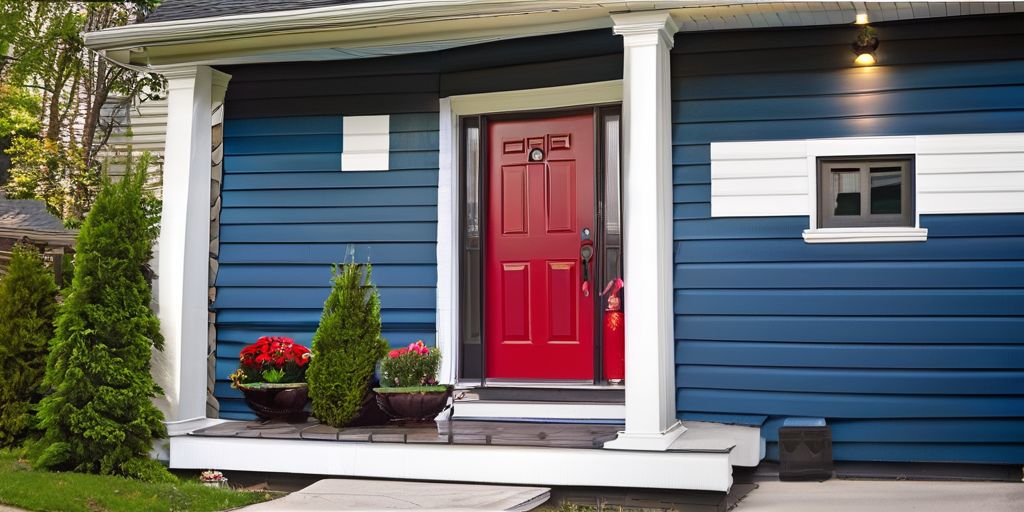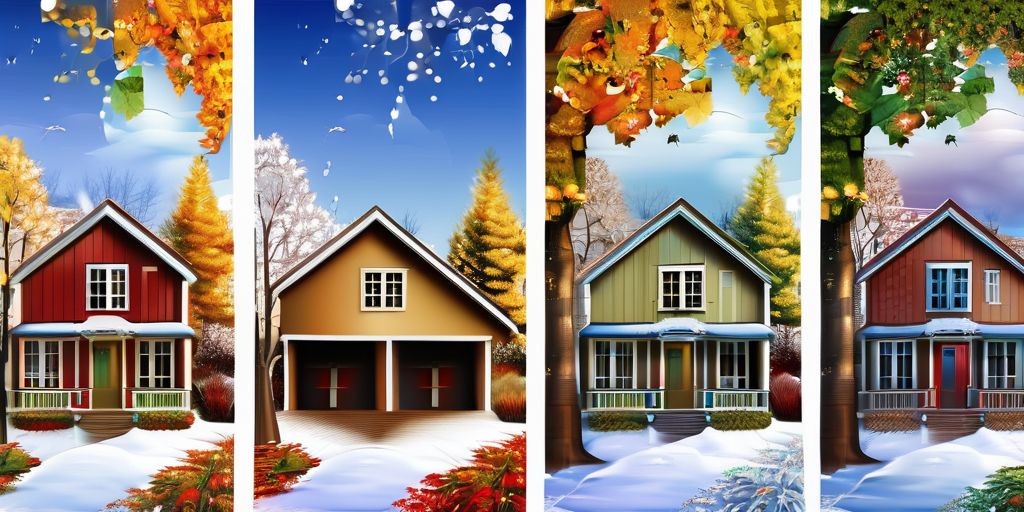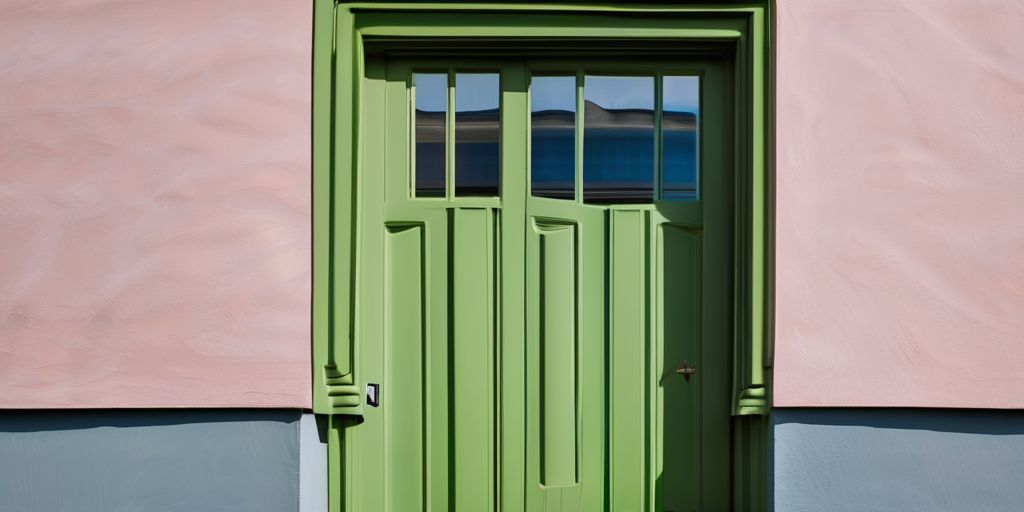Picking the perfect exterior house colors for 2024 can feel like a big deal. It’s not just about making your house look nice; it’s about creating a vibe that matches your style, fits your neighborhood, and even adds value to your home. Whether you’re into bold, modern hues or classic, timeless shades, this guide will help you figure it all out.
Key Takeaways
- Exterior house colors can boost your home’s curb appeal and resale value.
- Consider your home’s architecture and surroundings when choosing colors.
- Testing paint samples in different lighting is a must before deciding.
- Nature-inspired and earthy tones are trending for 2024.
- Professional advice and digital tools can simplify the selection process.
Understanding the Impact of Exterior House Colors for 2024
How Colors Influence Curb Appeal
Your home’s exterior color is the first thing people notice. It sets the tone for the entire property. A well-chosen color can transform a plain house into a standout beauty. Here’s why it matters:
- Bright or bold colors draw attention and make a statement.
- Neutral tones create a timeless, understated elegance.
- Soft pastels or earth tones can evoke warmth and approachability.
Think about how the color will look year-round, not just during one season. A color that pops in summer should still look inviting during winter.
The Role of Color in Home Value
Believe it or not, the right paint job can boost your home’s value. Buyers often associate well-maintained exteriors with quality interiors. Here’s how color ties into value:
- Homes with neutral or classic palettes tend to sell faster.
- High-contrast designs (like dark siding with light trim) are seen as modern and desirable.
- Colors that complement the neighborhood aesthetic can attract more interest.
Picking a color that feels personal but also appeals to the broader market is a smart move when thinking about resale.
Creating a Welcoming Atmosphere
Your home’s exterior isn’t just about looks—it’s about how it makes people feel. The right color can:
- Make a small house feel larger with lighter shades.
- Add coziness to a large home with darker, richer tones.
- Reflect the personality of the homeowner, from bold and adventurous to calm and serene.
Take your time to test and observe how different hues interact with your home’s architecture and surroundings. A warm, welcoming exterior is like a friendly smile—it sets the tone for what’s inside.
Choosing Colors That Complement Your Home’s Architecture
Matching Colors to Architectural Styles
Your home’s architectural style can act as a guide for selecting the perfect exterior paint colors. Each style has its own personality, and the right color palette can make it shine:
- Victorian Homes: These often look incredible with rich, bold hues like deep blues, greens, and even yellows. These colors highlight their intricate details beautifully.
- Colonial Style: Neutral tones like white or beige paired with dark shutters give a timeless, elegant look. If your home features red brick, earthy tones or gray with white trim can work wonders.
- Modern Designs: Sleek and simple shades like charcoal gray, crisp white, or even bold black can accentuate clean lines and minimalist aesthetics.
- Mediterranean Styles: Lighter shades like cream or beige paired with darker trim colors create a warm, inviting feel.
Highlighting Unique Features with Paint
Your exterior paint isn’t just about the walls; it’s also about what you want to emphasize. Using contrasting or complementary colors can draw attention to your home’s best features. Consider these tips:
- Use a lighter trim color to frame windows and doors, making them pop against darker siding.
- Highlight architectural details like columns, railings, or decorative moldings with a shade that contrasts the main color.
- Want to make your front door stand out? Go for a bold color like red, teal, or even black to create a focal point.
Balancing Modern and Traditional Aesthetics
Mixing modern and traditional styles can be tricky, but it’s a great way to achieve a unique look. Here’s how to strike the right balance:
- Start with neutral base colors like gray, beige, or white to maintain a timeless feel.
- Add modern touches with bold accent colors on doors, shutters, or even window frames.
- Use natural materials like wood or stone to bridge the gap between styles.
Remember, your home’s architecture is the star of the show. The right color palette should enhance its character, not compete with it.
By keeping these ideas in mind, you can create a cohesive exterior look that feels both stylish and true to your home’s roots.
Harmonizing Exterior Colors with Surroundings
Considering Landscape and Environment
Your home doesn’t exist in a bubble—it’s surrounded by nature, architecture, and seasonal changes. To make your house look like it belongs, consider these tips:
- Take cues from the landscape. If you’re near a wooded area, earthy tones like greens, browns, or taupes can blend beautifully with the surroundings. Homes near water might benefit from soft blues or sandy hues.
- Think about seasonal changes. A color that looks great in summer’s green might feel out of place in winter’s gray. Neutral tones tend to work well year-round.
- Account for lighting. Natural light can dramatically change how a color looks. Test shades during different times of the day to find one that holds up.
Blending with Neighborhood Aesthetics
Your home should stand out—but not in a way that clashes with the entire neighborhood. Here’s how to strike the right balance:
- Observe nearby homes. If your neighbors favor muted tones, a bright orange might feel jarring. Instead, aim for a complementary shade.
- Go a shade lighter or darker. Subtle variations can make your home unique without disrupting the neighborhood’s overall vibe.
- Add personality through accents. If the main color is neutral, a bold front door or colorful trim can still make a statement.
Using Nature-Inspired Palettes
Nature offers endless inspiration for color schemes. Earthy tones, in particular, are having a moment. Here are some ideas:
- Forest-inspired greens paired with crisp white trim create a grounded yet fresh look.
- Deep browns and tans mimic soil and stone, perfect for homes with brick or wood siding.
- Sky blues and soft grays can evoke a serene, airy feel, especially in open landscapes.
A well-chosen exterior color not only enhances your home’s curb appeal but also creates harmony with its surroundings. It’s about finding that balance where your house feels like it truly belongs.
Exploring Popular Exterior Color Trends for 2024
Timeless Neutrals and Their Appeal
Neutral colors remain a favorite for many homeowners. They’re versatile, classic, and work well with almost any architectural style. In 2024, expect to see shades like warm taupe, soft grays, and creamy whites dominating the scene. These tones are perfect for:
- Creating a clean, modern look.
- Enhancing the natural beauty of your home’s surroundings.
- Providing a neutral base to highlight bold accents like doors or shutters.
For those who want a subtle twist, consider muted beige or light gray with hints of green undertones. These colors offer a fresh take on traditional neutrals.
Bold and Vibrant Choices for a Statement
If you’re looking to make a statement, bold colors are your go-to. Deep blues, rich greens, and even fiery reds are gaining popularity. Here’s why they work:
- They add personality and charm to your home.
- Bold hues can make architectural details pop.
- They stand out in neighborhoods filled with more subdued tones.
Pair a vibrant color with contrasting trim (like crisp white or black) to balance the look. For instance, a dark navy exterior with white accents creates a striking yet sophisticated aesthetic.
Earthy Tones for a Natural Look
Earthy shades are making a big comeback, aligning with trends toward sustainability and nature-inspired designs. Think terracotta, olive green, and warm browns. These colors:
- Blend seamlessly with natural landscapes.
- Offer a cozy, grounded feel.
- Work well with materials like stone or wood accents.
To complete the look, incorporate complementary trim colors or textures. For example, pair a terracotta exterior with off-white trim and wooden shutters for a harmonious, rustic vibe.
When choosing exterior colors, always consider how they’ll look in different lighting conditions throughout the day. Testing samples on your home can save you from surprises later.
Tips for Testing and Finalizing Your Color Choice
Importance of Sampling Paint Colors
Before committing to a paint color, sampling is a must. Applying paint samples directly to your home’s exterior allows you to see how the color interacts with your home’s materials, surroundings, and lighting conditions. Here’s why it matters:
- Colors can appear different on textured surfaces like stucco or brick compared to smooth boards.
- Undertones, such as hints of blue or green in grays, become more apparent when viewed in natural light.
- Sampling ensures that the color complements existing elements like your roof, trim, or landscaping.
How Lighting Affects Color Perception
Lighting can make or break your color choice. A shade that looks perfect in the store might look entirely different on your house. Keep these tips in mind:
- Test colors in different lighting conditions—early morning, midday, and evening.
- Consider how shadows from trees or neighboring buildings affect the color.
- In sunnier climates, muted tones might look brighter, while in overcast areas, vibrant shades can add warmth.
Avoiding Common Color Selection Mistakes
Skipping key steps can lead to costly regrets. Here’s how to avoid common pitfalls:
- Don’t rely solely on small swatches. Paint large sections of your exterior to get a realistic view.
- Test multiple shades within your chosen color family to find the best fit.
- Avoid choosing colors based only on trends; instead, focus on what suits your home’s style and surroundings.
Taking your time to test and evaluate colors ensures that your final choice feels just right. It’s better to spend a little extra effort now than regret a rushed decision later.
Incorporating Accents and Details into Your Color Scheme
Choosing Trim and Door Colors
The trim and door colors of your home can make or break your exterior look. These smaller details can set the tone for your entire color scheme. Here’s how to approach it:
- Trim Colors:
- Door Colors:
Using Contrasting Shades for Depth
Adding contrasting shades is a simple way to bring depth and dimension to your home’s exterior. Here’s how you can use contrasts effectively:
- Pair light siding with darker trim or shutters to create visual interest.
- Use a darker shade on the lower part of your home and a lighter one on top for a grounded, balanced look.
- Highlight architectural details like columns, railings, or gables with a contrasting color to make them pop.
Highlighting Textures and Materials
Your home’s exterior isn’t just about color; it’s also about texture and material. Consider how paint interacts with these elements to enhance their natural beauty.
- If your home features brick or stone, choose paint colors that complement these materials instead of clashing with them.
- Use semi-gloss or satin finishes on wood accents to highlight their grain and texture.
- For stucco homes, softer, matte colors can emphasize the smooth or sandy texture while maintaining a cohesive look.
Thoughtful accents and details can completely transform your home’s exterior, turning it from ordinary to extraordinary. Pay attention to the small things—they often make the biggest impact.
Leveraging Professional Advice and Tools
Benefits of Consulting a Color Expert
Sometimes, choosing the perfect exterior paint color can feel like solving a puzzle. This is where a color expert steps in to help. Here’s why hiring one might be worth it:
- Personalized Guidance: They’ll consider your home’s architecture, surroundings, and even your personal style.
- Time-Saver: Avoid endless trips to the paint store by getting a professional opinion upfront.
- Avoid costly mistakes by ensuring the colors you pick work harmoniously together.
If you want to avoid common pitfalls, like overcomplicating your color scheme, a professional can guide you toward a cohesive and appealing look. Color psychology also plays a big role, and experts can help you navigate this effectively.
Using Digital Tools for Visualization
Gone are the days of guessing how a color might look on your home. With digital tools, you can:
- Upload a photo of your house.
- Experiment with different color combinations.
- See how lighting and time of day can affect the appearance.
These tools are a game-changer for homeowners who want a preview of their choices. Plus, they’re great for comparing options side by side. Remember, even tools that simulate exterior paint color combinations can reduce decision fatigue.
Top Paint Brands for Exterior Projects
When it comes to selecting paint, quality matters. The best exterior paints offer:
- Durability to withstand weather changes.
- A variety of finishes for different styles, from matte to glossy.
- UV resistance to keep your colors vibrant for years.
To make the most of your investment, choose paints that are specifically formulated for exteriors. Pairing the right paint with proper application techniques, like those outlined in this step-by-step guide, can ensure a long-lasting and beautiful result.
Pro Tip: Always test samples in different areas of your home’s exterior to see how they look in natural light. This small step can save you from disappointment later.
When it comes to painting your home, getting help from experts can make a big difference. Our team at We Paint Siding knows how to handle all the tricky parts of painting, especially for brick. We use a special method that combines spray painting with brushing to make sure the paint sticks well and looks great. If you’re thinking about giving your home a fresh look, visit our website for a free estimate and let us help you transform your space!
Wrapping It Up
Picking the perfect exterior paint color for your home doesn’t have to be overwhelming. Take your time, think about your home’s style, your neighborhood, and even how the light hits your house throughout the day. Don’t be afraid to test a few options before committing. Remember, it’s not just about following trends—it’s about finding a color that feels right for you and makes your home shine. Whether you go bold or stick with a classic neutral, the right choice can make all the difference. So grab those paint swatches and start dreaming up your home’s new look!
Frequently Asked Questions
Why is it important to choose the right exterior house color?
Picking the right color boosts your home’s curb appeal and can make it more attractive to visitors or potential buyers. It also helps create a welcoming and harmonious look that matches the home’s style and surroundings.
What should I consider when selecting an exterior paint color?
Think about your home’s architectural style, the colors of your roof and permanent materials, the surrounding landscape, and neighborhood trends. Also, decide if you want a bold or neutral look.
What are some popular exterior paint color combinations?
Classic combos like white with black trim, gray with white accents, or earthy tones like beige and taupe are popular. Bold choices include deep blues or greens paired with contrasting trims for a striking look.
How can I test paint colors effectively before committing?
Apply large samples of paint directly to your home’s exterior. Observe how the colors look at different times of the day and under various lighting conditions to ensure you’re happy with the choice.
Should I get professional help when choosing exterior colors?
Yes, consulting a color expert or using digital tools can make the process easier. Professionals can offer valuable advice and help you visualize how different colors will look on your home.
What are the best paint brands for exterior projects?
Top brands include Sherwin Williams, Benjamin Moore, Behr, and Valspar. These brands are known for their durability, coverage, and vibrant color options.

